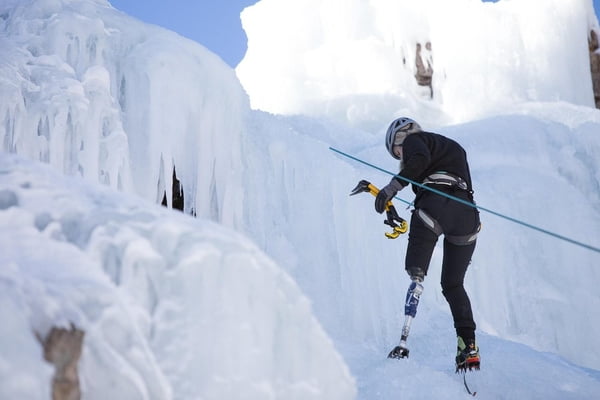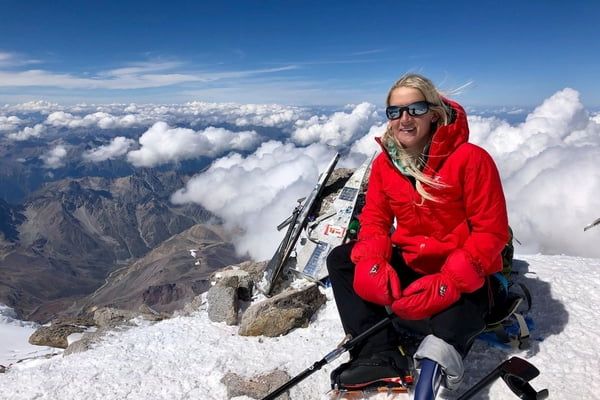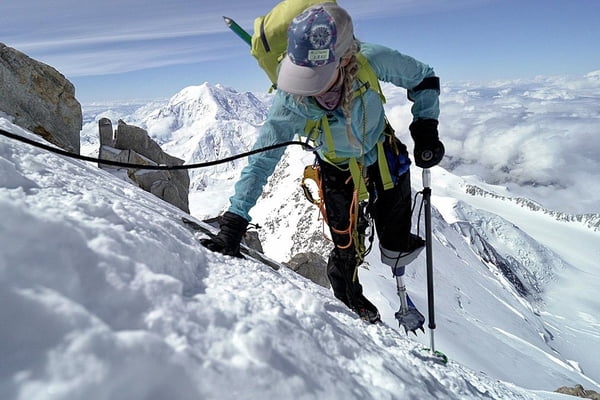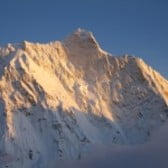
Daily Mountain
48 years, Australia
A Marine Vet Who Lost a Leg in a Helicopter Crash is About to Scale Everest
In 2012, US Marine Corps sergeant Kirstie Ennis suffered life-changing injuries in Afghanistan. Now, against all the odds, she's a mountaineer with plans on a full Everest climb.
“I went over to Nepal and made the trek up to Everest Base Camp. When the skies cleared on the third or fourth day, I saw her for the first time. I just cried."

While this kind of reaction isn’t uncommon for mountaineers on a pilgrimage to the Himalayas, for 27-year-old Kirstie Ennis, this vantage point represented a level of perseverance, dedication and heart that is inconceivable to most.
Six years ago, the US Marine Corps door gunner’s life was turned upside down when a helicopter crash in Afghanistan left her a leg down and fighting for her life. Now, against all the odds, she’s exploring a newfound passion for mountaineering by tackling the Seven Summits. And with three successful ascents already under her belt, it’s Everest proper that’s locked in her crosshairs for 2019.
Kirstie's story begins in the Marines - a job she knew she was destined for from an early age: "My parents were both Marines," she says. "I idolised them. Ultimately, I wanted to give them a reason to be proud of me, like I was of them. I wanted a taste of what it was like to serve a bigger purpose; to protect those who couldn’t protect themselves."
It’s a career that took Kirstie around the world, including several deployments to Afghanistan - a country which would later serve as a backdrop to the incident that would change her life forever.
June 23, 2012 started out much like any other day in Helmand: “We were meant to be doing combat resupplies, then headed to do an extraction of Marines,” she recalls. “We picked up three medics and were heading to operating base, Naw Zad.” However, as she and her crew were airborne, disaster struck. They never made it to their destination.
“With my night-vision goggles down, I remember feeling the nose of the aircraft drop, then my tail gunner called for power.” Before Kirstie was able to process what was happening, the helicopter had tipped back and was falling out of the sky. “That’s it,” she explains. “Once you lose your hover bubble, there’s nowhere to go, but smash into the ground.”
Kirstie remembers the moments following the impact in vivid detail. She came to, wedged between a large pallet and the wall of the helicopter. Breathing was near impossible and blood was rapidly filling her mouth. “I tasted copper and I was choking on grit.” That grit was composed of fragments of Kirstie’s jawbone and teeth. “I could fit my fist through the bottom right side of my face,” she recalls. “My jaw was non-existent.” Attempting to pull herself up, every effort was futile. “My arms kept collapsing and my leg was in a severe amount of pain. I screamed, but mainly out of shock and a confused attempt to try and wake my tail gunner up."

When 2nd Battalion 5th Marines came out to provide security, Kirstie was thrown into the back of another helicopter. “I remember being told not to close my eyes again because I wouldn’t open them back up. I had a picture of my mom, dad, and sister in my breast pocket - I always flew with it. I just stared at a cabin overhead light and told myself I wasn’t going to die without seeing my sister."
Kirstie's wounds were catastrophic. She suffered traumatic injuries to her brain, spine and face, as well as severe damage to her shoulders and one of her legs. Three years and more than 30 surgeries later, her lower left leg had to be amputated. A few months on, a second amputation had to be performed to remove the remainder of the limb above the knee due to infection.
“Once all of the wounds healed, it took about a month for the staples, stitches, and wound vac to come off,” Kirstie recalls. “It didn’t take me too long to get back on my feet. I was hellbent on getting out of there though, so I worked my ass off until physical therapy would actually let me take my prosthetic home.” It took her two weeks – a feat doctors would say is almost unheard of. But the real battle was still to come.
“Being an above the knee amputee is like being a toddler all over again,” Kirstie explains. “You have to learn absolutely everything – balance, walking, running, adjusting to different terrain. Even just learning to trust the prosthetics takes time. I would be lying if I said it were easy, or if I said it was pain free."
A lifelong athlete (and Colorado-based), Kirstie learnt to snowboard during her recovery and found she had real talent: "Snowboarding may have come naturally because I didn’t have any bad habits to break, or anything to compare it to for that matter. The hardest part about it was learning to transition and being comfortable with putting my weight forward onto my prosthetic. Luckily, I have a really amazing prosthetic knee with hydraulics built into it. Being able to adjust the resistance is extremely useful.

Carstenzs - the highest point in Oceania (16,024-ft) has been Kirstie's favourite climb so far: "Many will never understand why, but it was the mountain that has put the fear of God in me. After a summit day well into the double digits, an awful blizzard, we all ached. I was freezing, and when it came time to rappel down, I panicked. My cameraman got in my face and reminded me to get my shit together because the plaques we saw for the people who died on the mountain earlier, died there."
Denali, hovering over Alaska (20,322 ft), also wasn't without its challenges, says Kirstie: “The most difficult part of this was being pinned for 17 days at 14,000 feet. There was a lot of tent time and I am not good at sitting still."
That's something of an understatement. Not content with climbing iconic mountains, she also enjoys snowboarding down them where possible: “God willing, if everything goes according to plan, I intend to be the first amputee to snowboard parts of Everest,” she explains. “Obviously large sections of it are rocky, graced with crevasses, or simply just trashed, meaning I won’t be able to snowboard all of it - nor would I even think about it in the 'death zone.'"
The death zone, to the uninitiated, is the name mountaineers give high-altitude areas where there is insufficient oxygen to support breathing. This generally occurs above 8,000-metres and puts immense pressure on climbers and their equipment as from this point onwards, the human body is essentially dying. Nevertheless, it’s where Kirstie intends to be during spring 2019 when she’ll be heading back to Nepal for the climb of her life.
“I am extremely excited for the two months of Everest humbling me and it taking everything I’ve got,” Kirstie says. “I’ll have two American guides who I really trust joining me, along with a team of local Sherpas. I also intend to have close friends be my team at base camp. Additionally, we’ll be selling spots on our team for the trek to Everest Base Camp as a fundraiser for the Kirstie Ennis Foundation. Those who join us will be able to spend time with the team and I, then wish us well on our way as we begin the ascent."
As if it needs saying, snowboarding down Mount Everest isn’t without its risks, so Kirstie and her team will need to have their wits about them. “The reality is we will go solo,” she explains. “The first person will admittedly take most of the risks, and find the best line. I will have to keep my head on a swivel and be extremely self-aware. My lines will be always be on the high side along a ridge or some sort of feature so, should shit hit the fan, there’s still an option to get out."
Avalanches are certainly a risk, but it’s not Kirstie’s biggest concern: “Avalanches rarely just happen unexpectedly, so being able to judge angles and slide prone areas is huge. You need to look for signs of previous avalanches in the area. Things like slabs and wind-loaded slopes or an area abruptly changing from flat to steep. I found on Denali it was more difficult for me to judge where crevasses were than anything else."
Kirstie’s next stop before she tackles Everest will be Aconcagua, the highest mountain in not just South America, but also the southern and western hemispheres. She will travel with a fellow combat veteran, and if they summit successfully, it will mark the halfway point on Kirstie’s quest to climb the biggest mountains on each of the seven continents. The final stop in her Seven Summits challenge is set to be a return to Denali in 2020, to reattempt a climb that saw her and her team pinned at 14,000-ft for 17 days due to adverse weather.

It might mark her last climb of the Seven Summits, but it’s only the beginning for Kirstie and her career in adventure sports. “I don’t plan to stop climbing after this project,” she asserts. “I have already been looking to the future with climbing the North and South Poles, the Seven Volcanoes (highest volcano on each continent, swimming the English Channel and running seven marathons on seven continents in seven days."
It may sound extreme, but pushing her own limits is what got Kirstie through the darkest parts of her life: “I fought long and hard to stay out of a wheelchair – I fought to stay independent. Mountaineering is a constant reminder of my resiliency. No one will do this shit for me, I am the only person that can continue putting one foot in front of the other for myself and that’s what I intend to do."
Kirstie’s key climbs to date
- Summited Kilimanjaro, 5,895 m (19,341 ft) – highest point in Africa
- Summited Elrbus, 5,642 m (18,510 ft) – highest point in Europe
- Summited Carstenzs, 4,884 m (16,024 ft) – highest point in Oceania
- Summited Iliniza Norte, 5,126 m (16,818 ft) – Ecuador
- Attempted Denali, 6,194 m (20,322 ft)
- Attempted Cotopaxi, 5,897 m (19,347 ft) – Ecuador
Photo credit: Kirstie Ennis
This article first appeared on www.redbull.com. The original can be read here.





